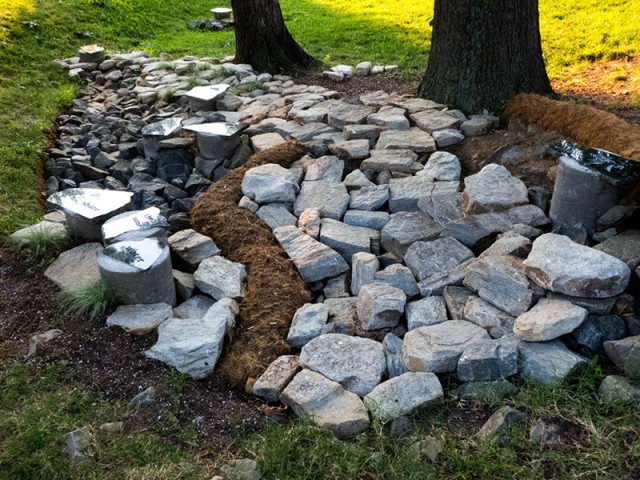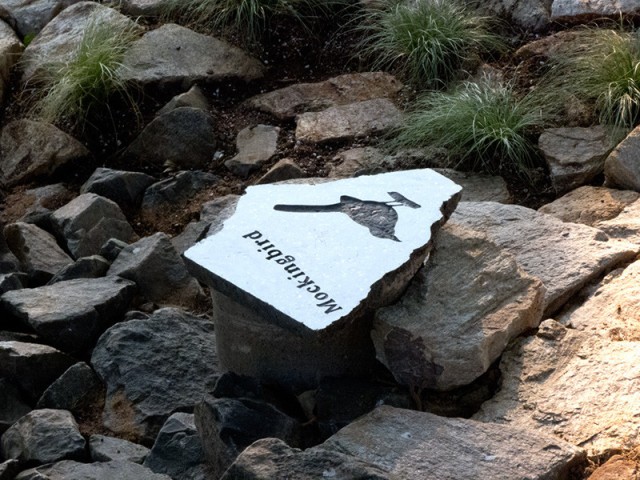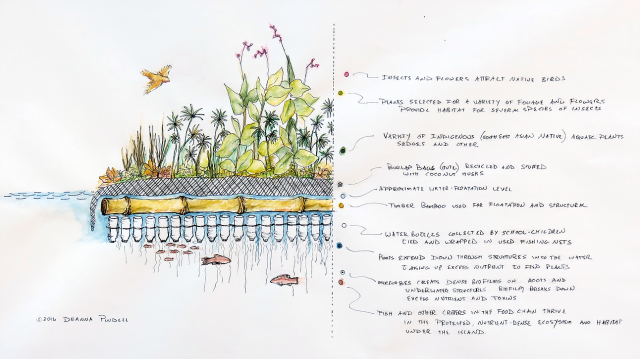Deanna Pindell es eco-artista y profesora en la Universidad de Washington-Tacoma. Tuve el honor de poder hablar con ella sobre su trabajo y sobre arte ecológico.
Deanna Pindell is an eco-artist and a teacher at University of Washington-Tacoma. I had the honor to talk to her about her work and about eco-art.
Empezamos nuestra conversación hablando del su manifiesto artístico. Había algo que había captado mi atención. Dice que en relación a los retos ambientales, lo que necesitamos es un cambio cultural porque el problema al que nos enfrentamos no es sólo de carácter científico sino también cultural.
We started our conversation talking about her art statement. There was something in it that caught my attention. She says that regarding environmental challenges, what we need is a cultural change because the problem we are facing are not just scientific but cultural.
El primer proyecto del que hablamos es Todos compartimos el mismo agua (2012) que fue realizado el Centro McColl en Charlotte (Carolina del Norte) en el que fue la segunda artista en residencia. El objetivo de este trabajo fue desacelerar el agua de escorrentía proveniente de un aparcamiento, estabilizar el suelo, filtrar el agua y capturar sustancias contaminantes antes de que llegaran a un lago. Ella y los alumnos de una escuela eligieron las especies de insectos, plantas, peces y aves propias del lugar cuyos nombres fueron tallados en granito e instalados en el lugar. El título de este proyecto viene de una conversación con un nativo Maorí en Nueva Zelanda. La artista se emocionó al contarme la historia. Ese hombre le dijo: todos compartimos el mismo agua. Cuando terminó este proyecto, fue capaz de hacer otro titulado Butterfly Bower en el cual limpió 4 yardas de suelo y plantó flores silvestres nativas para atraer a los polinizadores. La artista aprendió sobre las plantas adecuadas investigando y trabajando con los invernaderos de la zona.
The first project we talked about was We All Share the Same Water (2012) that was done in the McColl Center in Charlotte (North Carolina) where she was the second artist in residence. The goal of this work was slow down the storm water coming from a parking lot, keep the soil in place, filter the water and catch pollutants before it goes to a pond. She and the students from a school chose the species of insects, plants, fish and birds of that place whose names were carved in granite and installed in the place. The title of this project comes from a conversation with a Maori man in New Zealand. She got moved when she told me this story. That man told her: “we all share the same water”. When she finished this project, she was able to develop a second one called Butterfly Bower, in which she cleaned 4 yards of topsoil and planted native wildflowers to attract pollinators. She learnt about the right plants doing research and working with nurseries from the area.
 We all share the same water (from Deanne Pindell’s website) / Todos compartimos el mismo agua (de la página web de Deanne Pindell).
We all share the same water (from Deanne Pindell’s website) / Todos compartimos el mismo agua (de la página web de Deanne Pindell).
 We all share the same water (from Deanne Pindell’s website) / Todos compartimos el mismo agua (de la página web de Deanne Pindell).
We all share the same water (from Deanne Pindell’s website) / Todos compartimos el mismo agua (de la página web de Deanne Pindell).
 Butterfly Bower (from Deanne Pindell’s website) / Butterfly Bower (de la página web de Deanne Pindell).
Butterfly Bower (from Deanne Pindell’s website) / Butterfly Bower (de la página web de Deanne Pindell).
En el proyecto Squiggle Salal en Port Angeles (Washington) la artista eliminó las plantas invasivas y plantó arbustos de salal. Diseñó estructuras de arpillera donde las semillas fueron plantadas. En este proyecto también reconoce la importancia cultural de esta planta para los pueblos nativos introduciendo el nombre del arbusto en ochos lenguas indígenas diferentes en las estructuras de arpillera. Así que está contribuyendo a la restauración ecológica del lugar y además está poniendo encima de la mesa la memoria del lugar y la importancia de una cultura que fue capaz de vivir con el lugar de una manera sostenible. Tenemos muchas cosas que aprender de ellos.
In the project Squiggle Salal in Port Angeles (Washington) she removed invasive plants and replaced them with a native shrub, Salal. She designed burlap wattles where the seeds were planted. In this project, she also recognizes the cultural importance of this plant for the Native people introducing its name in eight different Pacific Northwest Indigenous languages in the wattles using black wool. So she is contributing to the ecological restoration of the place but she is also bringing to the table the memory of the place and the importance of a culture that was able to live with the place in a sustainable way. We have so many things to learn from them.
 Squiggle Salal (from Deanne Pindell’s website) / Squiggle Salal (de la página web de Deanne Pindell).
Squiggle Salal (from Deanne Pindell’s website) / Squiggle Salal (de la página web de Deanne Pindell).
Después de hablar de estos proyectos le hice dos preguntas. La primera en relación al conocimiento que los artistas necesitan para trabajar en un lugar en el que son extraños. Para contestar esta pregunta, se refiere al proyecto Koh Seametry en Tonli Bati (Cambodia, 2016) donde construyó con los estudiantes de un colegio una isla artificial en un lago de drenaje con el fin de mejorar la calidad de su agua. Este proyecto de arte ecológico fue comisionado por Muoy You, fundadora y directora del colegio Seametrey Montessori Children’s Village. Usaron botellas de plástico, fibras naturales, bambú y plantas de humedal que son capaces de filtrar el agua y generar hábitat para los peces debajo de la isla. En este caso, su acercamiento al lugar empezó con una investigación antes de ir a Camboya. Investigó aspectos como qué tipo de arte se hace en ese país o a qué retos se enfrentan. También tenía una serie de contactos de la escuela donde iba a trabajar a los cuales escribió y que fueron muy útiles para empezar a aprender al lugar. Le dijeron que un tema potencial sobre el que poder trabajar era la laguna contaminada. Por lo tanto, el artista no llega al lugar con una idea preconcebida sino que el proyecto es desarrollado durante el diálogo con la gente y el lugar. Por ejemplo, la isla iba a tener forma de tortuga pero al parecer no les gustan las tortugas en ese lugar por lo que la forma cambió a la de una flor ornamental, el Kbach khmer. La artista también destaca que investigó en profundidad para poder conocer cuáles eran las plantas más adecuadas para la isla.
After talking about these projects I asked her two questions. The first one was regarding to the knowledge that artists need to work in a place where they are outsiders. To answer this question she referred to her project Koh Seametry in Tonli Bati (Cambodia, 2016) where she built with the students of a school an artificial island in a drainage pond in order to improve the quality of the water. This ecological art project was commissioned by Muoy You, founder and director of the school, Seametrey Montessori Children’s Village. They used plastic bottles, natural fibers, bamboo and wetland plants that are able to filter the water and generate habitat for fish underneath the island. In this case, her approach to the place started with a research before going to Cambodia. She researched aspects like what kind of art is done in that country or what challenges they are facing. She also had some contacts from the school that she emailed before going that were helpful to start learning from the place. They told her that one potential issue to deal with was the polluted pond. Therefore, the artist did not go to that place with a preconceived idea but it was developed in the dialogue with the people and the place. For instance, the island was going to be with the shape of a turtle but she learnt that they don’t like turtles so it has the shape of an ornamental flower, the kbach khmer. The artist also underlined that she researched very hard to learn about the different appropriate plants for the island.
 Koh Seametry (from Deanna Pindell’s website) / Koh Seametry (de la página web de Deanna Pindell).
Koh Seametry (from Deanna Pindell’s website) / Koh Seametry (de la página web de Deanna Pindell).
 Koh Seametry (from Deanna Pindell’s website) / Koh Seametry (de la página web de Deanna Pindell).
Koh Seametry (from Deanna Pindell’s website) / Koh Seametry (de la página web de Deanna Pindell).
La segunda pregunta trataba sobre los valores que el artista suma a este tipo de proyectos de restauración ecológica. Ella piensa que los artistas no sólo trabajan en los aspectos técnicos de la restauración sino que ellos también están afectando la cultura, están cambiando su perspectiva acerca del lugar y acerca de cómo vivir en él. También pueden tratar más temas relacionados con la sociedad y no sólo la parte científica.
The second question dealt with what values the artist can bring to this kind of projects of restoration ecology. She thinks that artists not only are working on the technical aspects of the restoration but they are also affecting the culture, they are changing their perspective about the place and about how to live in it. They can also embrace more issues related with society and not only the scientific stuff.
He podido ver un vídeo donde tres niños de la escuela son entrevistados y explican cómo fue diseñada la isla flotante y cómo ésta va a mejorar el ecosistema. Realmente saben cómo funciona. Y creo que, más allá de los aspectos de la restauración, este valor no tiene precio. El valor de introducir a los niños a este tema, el hecho de trabajar con ellos, enseñarles cómo hacerlo y compartir con ellos la ilusión de un proyecto es un aspecto muy destacable de este proyecto. Además de esto, desarrollan la conexión de la comunidad y genera lo que yo llamo red de aprendizaje. Esto es que el artista inicia una cadena de preguntas, respuestas, conexiones entre la gente que sabe acerca del tema, entre la gente que quiere ayudar o tienen curiosidad en el proyecto. Todos ellos aprenden del lugar y de sus sistemas y también sobre la gente. Estas redes de aprendizaje y conexiones son las ricas semillas que el artista planta en el lugar que puede generar nuevas iniciativas en el futuro y el cambio en la cultura que reclamaba Deanne Pindell. En conclusión, la artista está empoderando a la comunidad y conectándola con el entorno.
I was able to watch a video were three kids from the school are interviewed and they explain how that floating island was designed and how it is going to help to improve the ecosystem. They really knew how it works. And I think that, besides the restoration aspect, this value is priceless. The value of bringing the issue to the kids, work with them, teach them how to do it and share with them the illusion of a project is a very remarkable aspect of this project. In addition to that, they developed connection with the community and generate what I call a “network of learning”. This is that the artist started a chain of questions, answers, connections between people who know about the issue, people who want to help or that are curious about the project. All of them learn about the place and its systems and also about the people. These networks of learning and connections are the rich seeds that the artist plant in the place and that can generate new initiatives in the future and a change in the culture that Deanne Pindell reclaims in her statement. In conclusion, the artist is empowering the community and connecting it with the environment.
Deanna Pindell tiene experiencia trabajando con científicos en la que ha encontrado tres diferentes maneras de entender esta colaboración. La práctica artística puede entenderse simplemente como una ilustración de la ciencia. Podría haber otra manera en la que científico y artista trabajan así que la colaboración es más auténtica y enriquecedora. Y hay una tercera vía en la que ella misma va a participar. Esto es cuando el artista y el científico se eligen mutuamente porque tienen intereses similares, porque conectan y están deseando aprender del otro. Deanne Pindell participó en un evento llamado Surge Speed Dating Night en el Museo de Arte del Noroeste en la población de La Conner (Washington) cuyo objetivo es generar colaboración entre científicos y artistas para trabajar sobre el Cambio Climático y desarrollar una exposición en 2018. Ella fue una de las artistas que presentó su trabajo y que posiblemente colaborará con un científico para hacer una propuesta. Me gustaría introducir aquí otros tres conceptos que están relacionados con la observación que hacía Deanne Pindell acerca de las diferentes formas de colaborar entre científicos y artistas. Son multidisciplinariedad, interdisciplinariedad y transdisciplinariedad como son definidas por Basarab Nicolescu (2002). Un proyecto multidisciplinar estudia un tema desde diferentes disciplinas (Nicolescu, 2002, p. 42). En un proyecto interdisciplinar se produce “una transferencia de métodos de una disciplina a otra” (Nicolescu, 2002, p. 43). Finalmente:
Como el prefijo trans indica, transdisciplinariedad concierne a lo que está a la vez entre disciplinas, atravesando las diferentes disciplinas y más allá de todas las disciplinas. Su objetivo es el entendimiento del mundo presente, del cual uno de los imperativos es la unidad de conocimiento. [258] (Nicolescu, 2002, p. 44)
Deanna Pindell has experience working with scientists so she has found three different ways of understanding this collaboration. It could be that art is understood just as an illustration of the science. There could be another way where both, scientist and artist, work together so the collaboration is more authentic and enriching. And there is a third way in which she is going to participate. This is when artist and scientist chose each other because they have similar interests, they connect, and they are willing to learn from each other. Deanne Pindell participated in an event called Surge Speed Dating Night in the Museum of Northwest Art in La Conner which goal was to generate collaboration between scientists and artists to work on Climate Change and to develop an exhibition for 2018. She was one of the artists who presented her work and hopefully she will collaborate with a scientist to make a proposal. I would like to introduce here other three concepts that are related with this observation of Deanne Pindell. They are multidisciplinarity, interdisciplinarity and transdisciplinarity as they are defined by Basarab Nicolescu (2002). A multidisciplinary project studies a topic from different disciplines (Nicolescu, 2002, p. 42). Interdisciplinarity means that there is a “transfer of methods from one discipline to another” (Nicolescu, 2002, p.43). Finally:
Transdisciplinarity concerns that which is at once between the disciplines, across the different disciplines, and beyond all discipline. Its goal is the understanding of the present world, of which one of the imperatives is the unity of knowledge (Nicolescu, 2002, p. 44).
Por lo tanto, en una colaboración interdisciplinar a veces la transdisciplinariedad puede tener lugar. Esto significa que lo inesperado puede ocurrir, que la magia puede ocurrir. Creo que este tipo de colaboraciones son las que tanto el evento en el Museo de Arte del Noroeste y también la artista Deanne Pindell están buscando.
Therefore, from an interdisciplinary collaboration sometimes transdisciplinarity can happen. It means that unexpected outputs can happen, magic can happen. I think these kind of collaborations are what the event in the Museum of Northwest Art and also Deanne Pindell are looking for.
Deanna Pindell tiene muchos otros proyectos interesantes sobre medioambiente que involucren a la comunidad. Recomiendo visitar la página web de la artista para aprender más sobre esos proyectos. Encuentro que Deanne Pindell es una artista muy interesante que realmente siente lo que hace y que es un ejemplo destacable de una artista ecológica prolífica y muy inspiradora. Soy afortunado de conocerla y espero colaborar con ella en el futuro.
Deanna Pindell has many other interesting projects dealing with the environment and engaging the community. I strongly recommend that you have a look of her website to learn more about those. I find that Deanne Pindell is an amazing artist that feels very deeply what she does and that is a remarkable example of a prolific and inspiring eco-artist. I am lucky to know her and I hope we can collaborate in the future.

Pingback: Noche de encuentros (Artistas-Científicos) / Surge Speed Dating Night (Artists-Scientists) | Antonio José García Cano